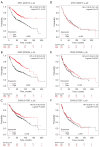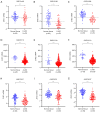Decreased zinc-fingers and homeoboxes family expression was associated with unfavorable outcomes and immune infiltration in lung adenocarcinoma
- PMID: 37434685
- PMCID: PMC10331706
- DOI: 10.21037/tcr-22-2793
Decreased zinc-fingers and homeoboxes family expression was associated with unfavorable outcomes and immune infiltration in lung adenocarcinoma
Abstract
Background: The zinc-fingers and homeoboxes (ZHX) family is a group of nuclear homodimeric transcriptional repressors that play an essential role in developing and progressing diverse malignancies. However, the association of ZHX family expression with prognosis and immune infiltration in lung adenocarcinoma (LUAD) is still unclear. The current study aimed to investigate the relationship between ZHX family expression and clinical outcomes and immune infiltration in LUAD patients.
Methods: ZHXs family expression was determined by using the Oncomine database and Cancer Cell Line Encyclopedia (CCLE). The impact of ZHXs family expression on prognosis was analyzed by using the Kaplan-Meier-plotter online database. The Search Tool for the Retrieval of Interacting Genes (STRING) database was utilized to construct the interaction network based on the selected differentially expressed genes associated with ZHXs. The Database for Annotation, Visualization, and Integrated Discovery (DAVID) was used to perform the enrichment of the Gene Ontology (GO) and Kyoto Encyclopedia of Genes and Genomes (KEGG) pathways. The functional state of the ZHXs family in diverse types of malignancies was determined by CancerSEA. The Tumor Immune Estimation Resource (TIMER) database was used to evaluate the association of the ZHXs family with immune cell infiltrates. ZHXs family expression was validated by the Gene Expression Omnibus (GEO) database and real-time polymerase chain reaction (RT-PCR) in 10 paired tumors and normal tissues.
Results: ZHX1-3 expression level significantly decreased in LUAD compared with normal tissues. Attenuated ZHXs expression was significantly associated with unfavorable overall survival in LUAD patients. ZHX family members were positively associated with immune infiltration of monocytes, tumor-associated macrophages (TAMs), M1 and M2 macrophages in LUAD. ZHX family expression was also significantly related to a variety of immune marker sets in LUAD. GEO analysis and RT-PCR validated the significant decrease of ZHXs expression level in LUAD.
Conclusions: The current study revealed that ZHX family expression was significantly correlated with unfavorable outcomes and immune infiltration in LUAD. The findings herein provide a promising basis for further study into the potential biological function of the ZHX family in LUAD and lay a foundation for developing therapeutic targets for LUAD patients.
Keywords: Zinc-fingers and homeoboxes family (ZHX family); immune infiltration; lung adenocarcinoma (LUAD); prognosis.
2023 Translational Cancer Research. All rights reserved.
Conflict of interest statement
Conflicts of Interest: All authors have completed the ICMJE uniform disclosure form (available at https://tcr.amegroups.com/article/view/10.21037/tcr-22-2793/coif). The authors have no conflicts of interest to declare.
Figures







Similar articles
-
Elevated nuclear expression of ZHX1 correlates with poor prognosis in hepatocellular carcinoma (HCC): Comparison of nuclear and cytoplasmic distribution of the ZHX family in HCC cells.Hepatol Res. 2024 Aug 29. doi: 10.1111/hepr.14100. Online ahead of print. Hepatol Res. 2024. PMID: 39207766
-
SPTBN2, a New Biomarker of Lung Adenocarcinoma.Front Oncol. 2021 Oct 20;11:754290. doi: 10.3389/fonc.2021.754290. eCollection 2021. Front Oncol. 2021. PMID: 34745988 Free PMC article.
-
Role of CENPL, DARS2, and PAICS in determining the prognosis of patients with lung adenocarcinoma.Transl Lung Cancer Res. 2024 Oct 31;13(10):2729-2745. doi: 10.21037/tlcr-24-696. Epub 2024 Oct 28. Transl Lung Cancer Res. 2024. PMID: 39507047 Free PMC article.
-
Zinc Fingers and Homeobox Family in Cancer: A Double-Edged Sword.Int J Mol Sci. 2022 Sep 22;23(19):11167. doi: 10.3390/ijms231911167. Int J Mol Sci. 2022. PMID: 36232466 Free PMC article. Review.
-
Zinc fingers and homeoboxes family in human diseases.Cancer Gene Ther. 2015 May;22(5):223-6. doi: 10.1038/cgt.2015.16. Epub 2015 Apr 10. Cancer Gene Ther. 2015. PMID: 25857360 Review.
References
LinkOut - more resources
Full Text Sources
